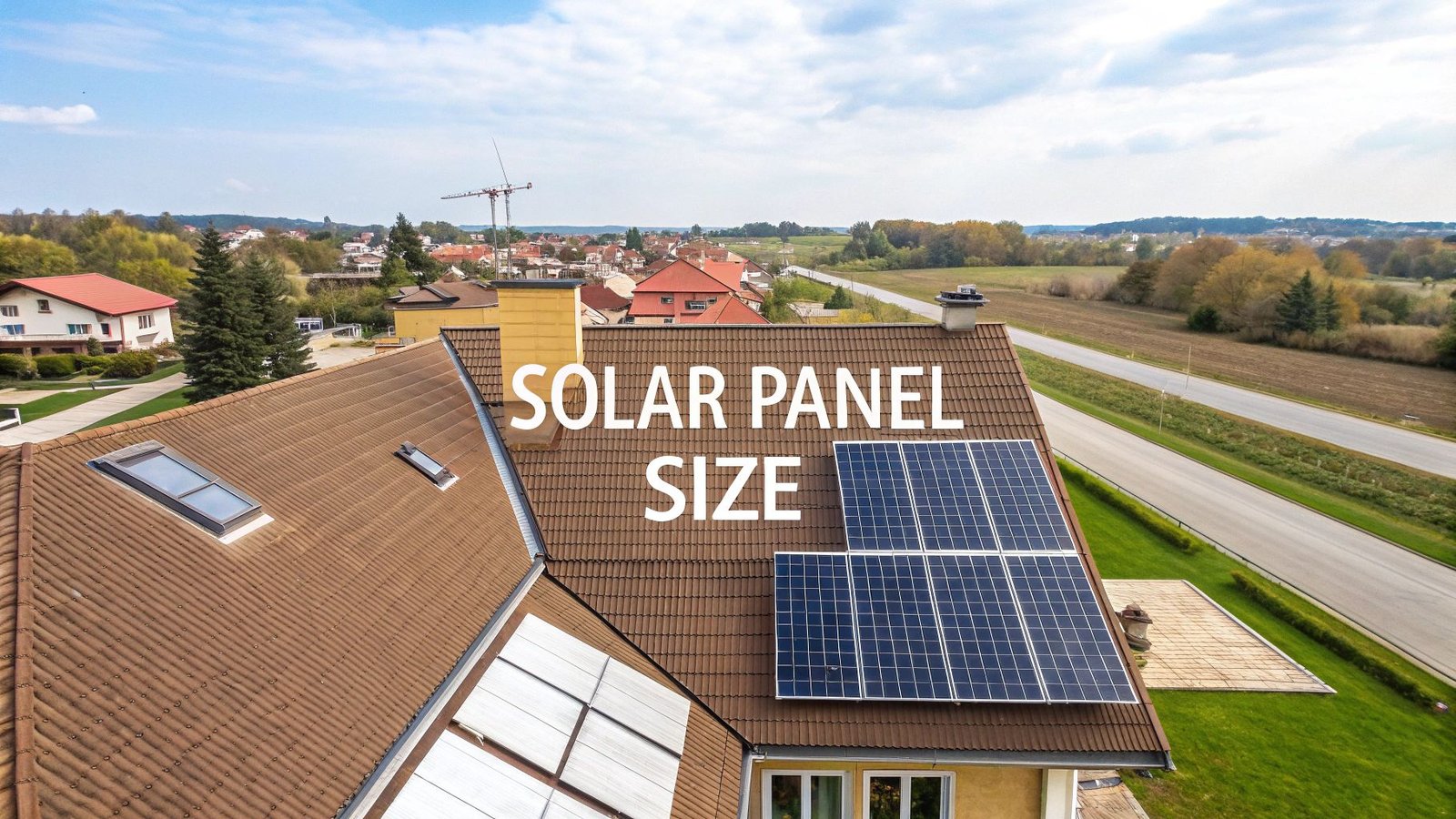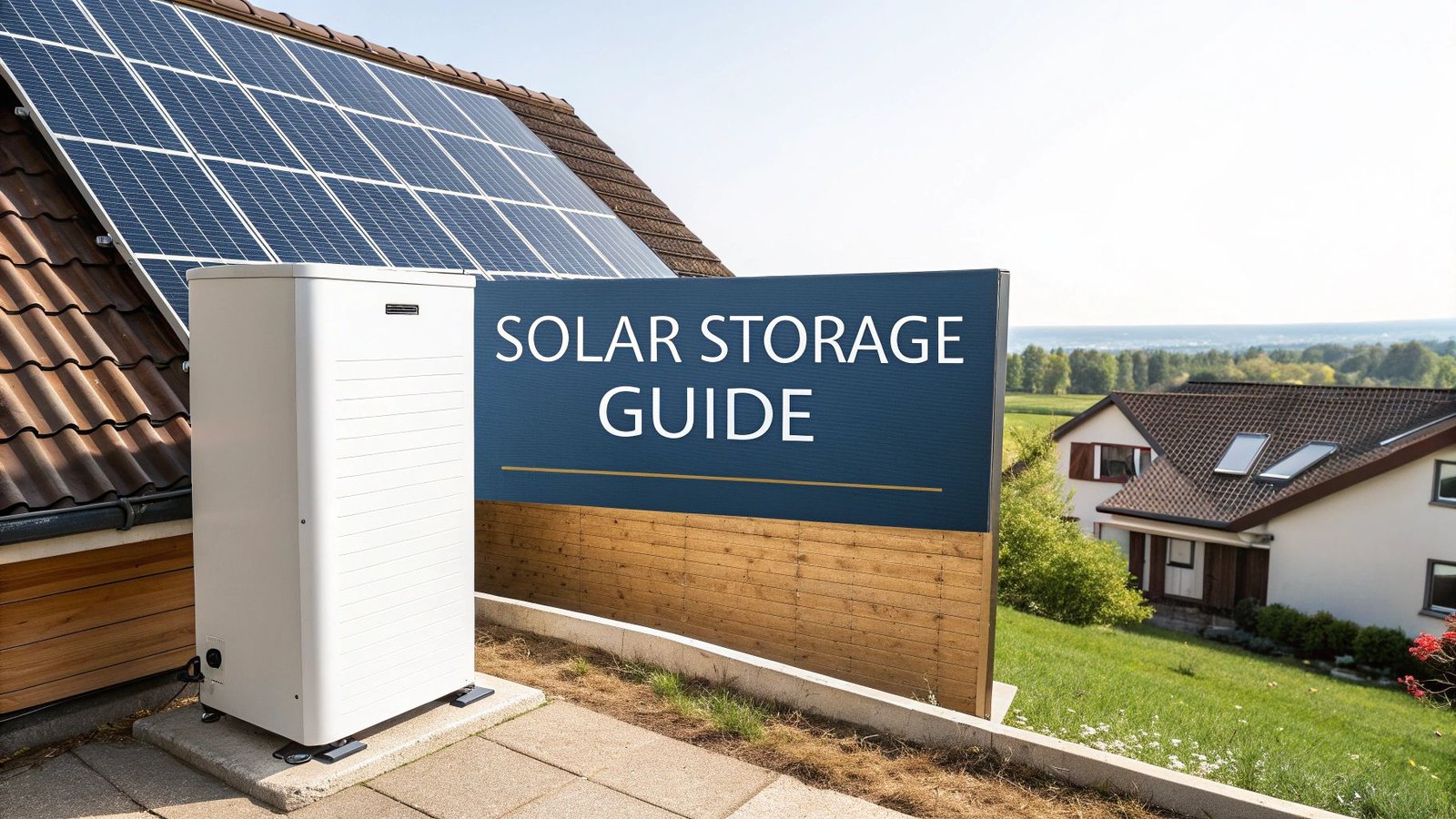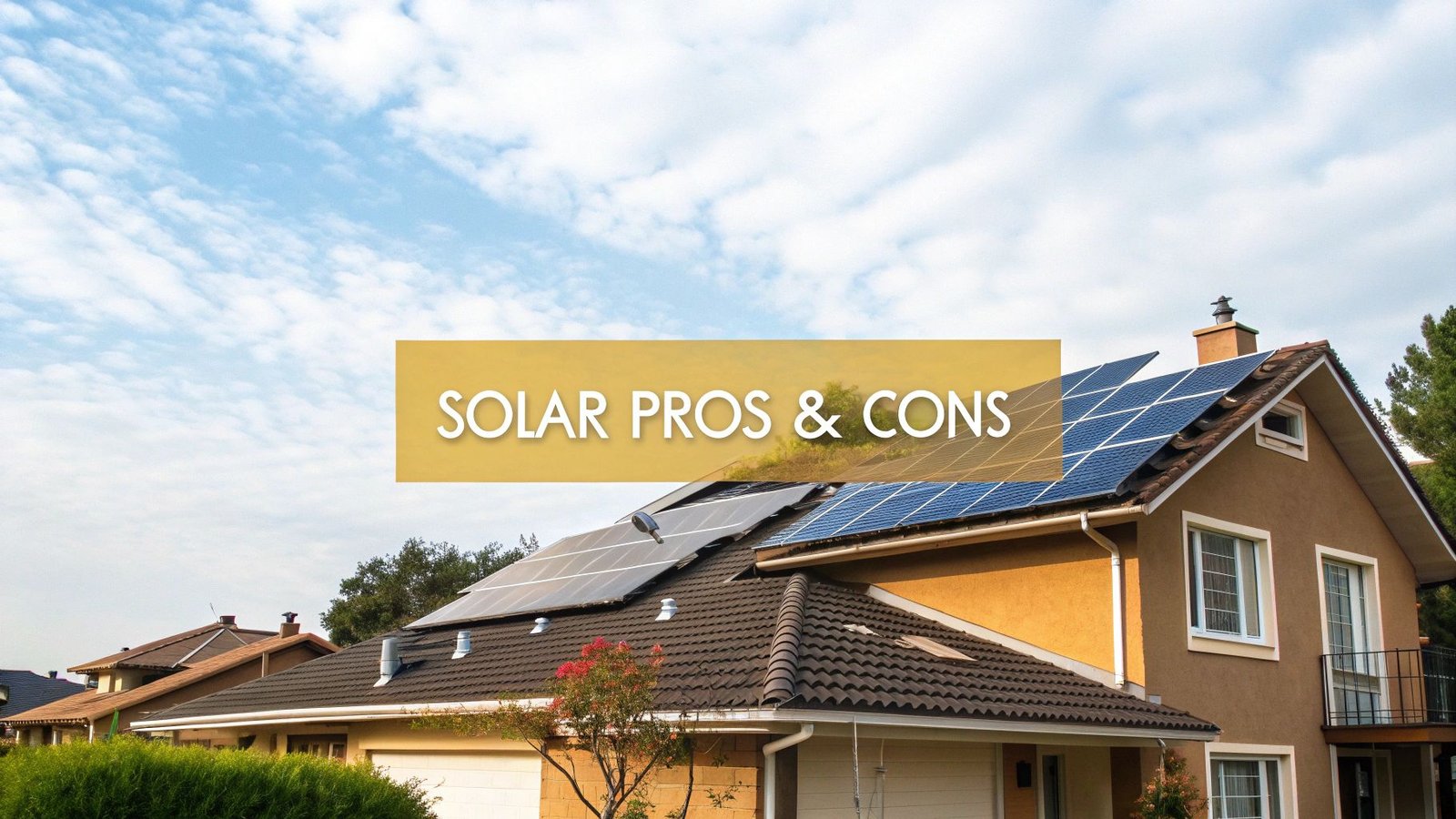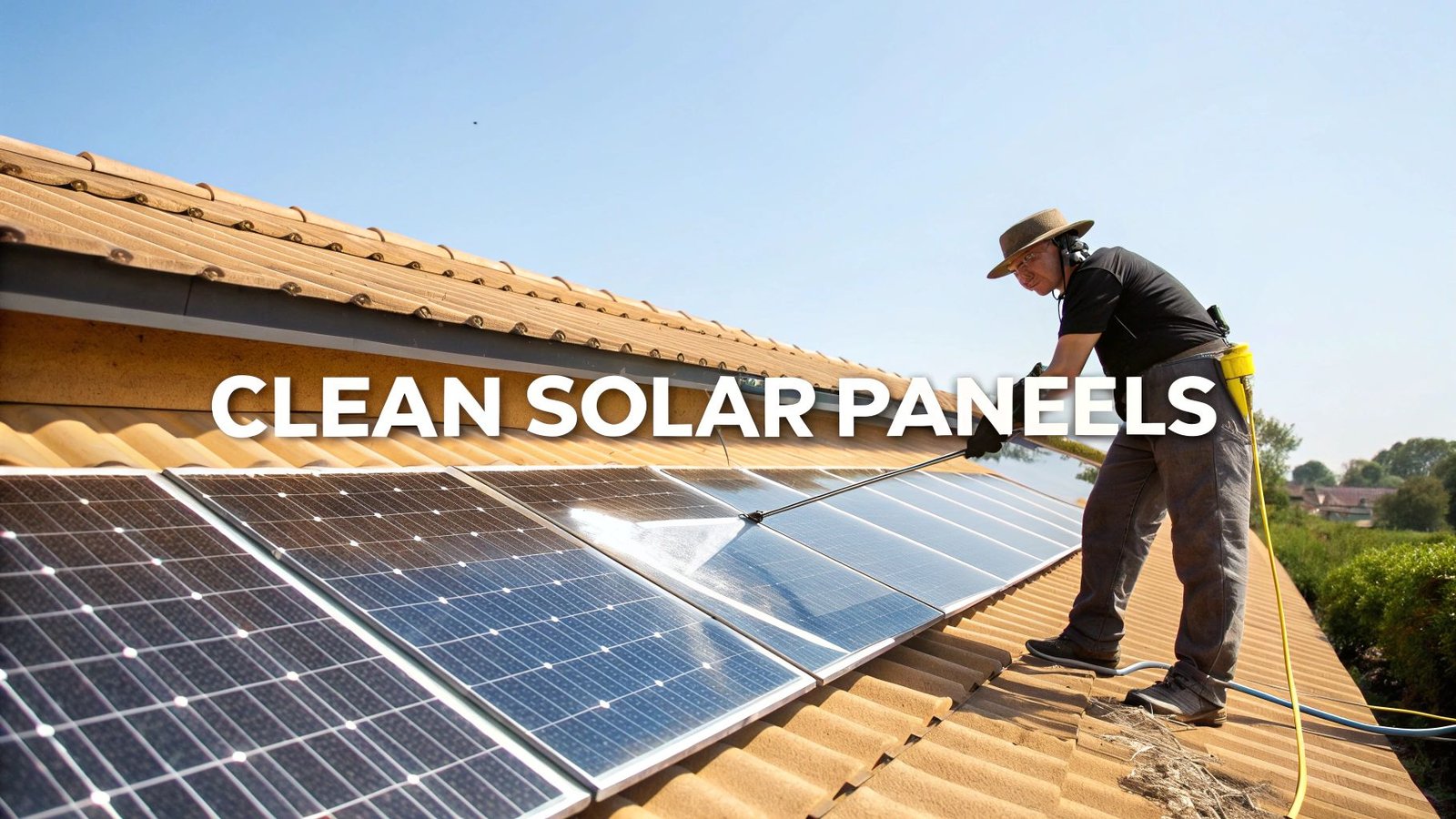When people talk about "solar panel size," they're usually juggling two key ideas: the panel's physical footprint (how much real estate it'll take up on your roof) and its power output, which we measure in watts.
A pretty standard residential solar panel is about 65 inches by 39 inches, but the wattage you get from that space can vary wildly depending on the technology packed inside. Finding the right "size" for your home really comes down to balancing your available roof space, how much energy you actually use, and your budget.
Decoding Solar Panel Size for Your Home
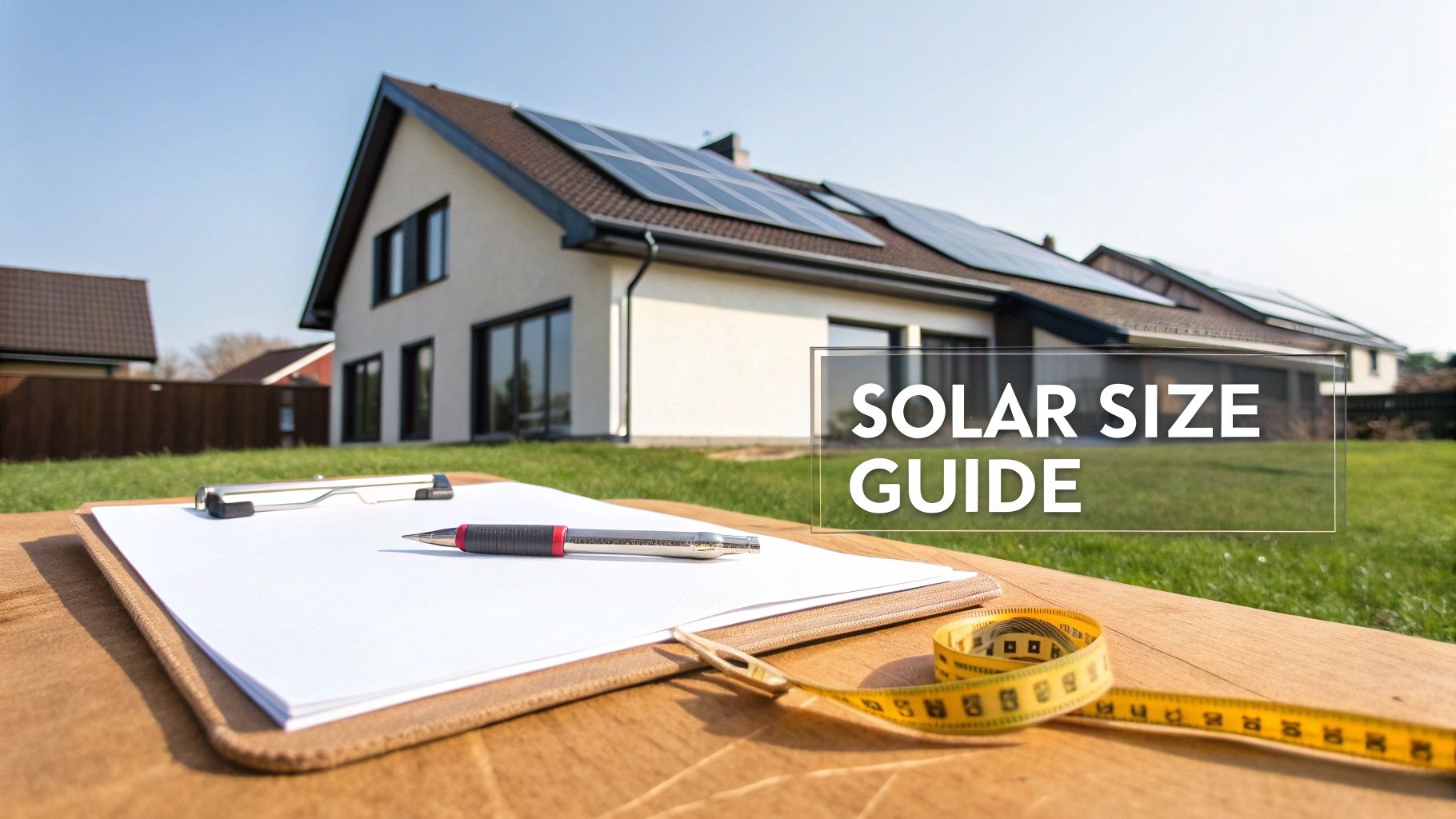
Getting a handle on solar panel size is the first real step in designing a system that’s a perfect fit for your home. It’s less about a single measurement and more about how a panel's dimensions and its power-producing muscle work together. These two things ultimately decide how much electricity your system can crank out.
There’s no magic bullet here. The ideal panel for you hinges on a few personal factors:
- Your Home's Energy Consumption: How much juice does your family typically use each month? A quick look at your utility bill is the best place to start.
- Available Roof Space: How much unshaded, south-facing roof do you have to work with? Obstacles like vents and chimneys matter.
- Local Climate and Sunlight: How many hours of strong, direct sunlight does your area get? This is a huge factor in overall production.
- Your Financial Goals: Are you trying to wipe out your electricity bill entirely, or are you working within a specific upfront budget?
A Quick Look at Common Panel Sizes
The good news is that the solar industry has been moving fast, and today's panels are more powerful and efficient than ever. Not too long ago, panel efficiency was hovering around 15%. Now, it's common to see standard residential models hitting over 22%.
What does that mean for you? It means you can generate more power from a smaller footprint. The average residential panel these days is still around that 65-by-39-inch mark, which is a sweet spot that balances power output with being manageable for installers to carry up a ladder. You can get more great insights into the global PV market on the IEA PVPS website.
To give you a better feel for this, let's break down the common types of residential panels. One of the main ways they're categorized is by the number of photovoltaic cells they contain, which directly impacts both their physical size and how much power they produce.
Choosing the right panel is like picking the right tool for a job. A larger panel isn't always better if a smaller, more powerful one fits your space and goals more effectively.
Quick Guide to Residential Solar Panel Sizes
To help you visualize your options, this table breaks down the most common residential solar panel types, showing their typical dimensions and power output.
| Panel Type (Cell Count) | Typical Dimensions (Inches) | Average Wattage Range (W) | Lo mejor para |
|---|---|---|---|
| 60-Cell Panels | 65" x 39" | 300W – 370W | Standard residential roofs with adequate space |
| 66-Cell Panels | 68" x 41" | 360W – 430W | Homes needing slightly more power per panel |
| 72-Cell Panels | 77" x 39" | 380W – 460W | Larger roofs or ground-mounts to maximize output |
| 96-Cell Panels | 66" x 45" | 400W – 500W+ | High-efficiency needs where space is a premium |
As you can see, the dimensions don't always scale directly with the power output. Advances in cell technology mean that a more compact 96-cell panel can often produce significantly more power than a physically larger 72-cell panel. This is where discussing your specific needs with an installer becomes invaluable.
Dimensions vs. Wattage: The Two Sides of Solar Panel "Size"
When people talk about solar panel "size," it's easy to get confused. The term actually pulls double duty, referring to two very different, but equally important, things. To really get a handle on what you need for your home, you have to understand both sides of the coin.
First, there’s the most obvious meaning: physical size. This is simply the panel's length and width, its actual footprint. It’s what tells you how many panels you can physically line up on your roof. Think of it as the real estate each panel occupies.
But the physical dimensions are only half the picture. The second, and arguably more important, meaning of "size" is a panel's power output, which we measure in watts. This wattage rating is the true engine of your solar system, telling you how much electricity a panel can crank out under perfect, lab-tested conditions.
The Power Inside the Panel
This is where things get interesting. You can have two solar panels that are physically identical—same length, same width—but produce wildly different amounts of energy. How? It all comes down to efficiency.
A high-efficiency panel is just better at its job. It can take the same amount of sunlight hitting its surface and convert more of it into usable electricity. So, a standard residential panel measuring 65" x 39" might be rated for 350 watts. But a high-efficiency panel of the exact same physical size could be rated for 440 watts or even more.
A panel's wattage is its true measure of power. When you're comparing options, focus on the watts, not just the physical footprint. That’s how you compare performance.
Seeing the Difference in Real-World Output
Let's put this into a real-world scenario. Say you have a limited amount of sunny, unobstructed roof space. This is where wattage becomes your most important number.
Choosing a panel with a higher wattage rating lets you squeeze more power out of that limited area. This is a game-changer for smaller homes or roofs crowded with things like vents, skylights, or chimneys.
This chart compares two common panels of the same physical size to show how efficiency boosts power output.
Power Output by Efficiency (65" x 39" Panel)
| Type of Panel | Eficacia | Wattage Output |
|---|---|---|
| Panel estándar | 18% | 350 W |
| High-Efficiency Panel | 22% | 440 W |
Even though they take up the exact same amount of space, the high-efficiency panel generates over 25% more power. This efficiency boost could mean you need fewer panels to hit your energy goals, potentially lowering installation costs and leaving you room to expand your system down the road. Nailing down this relationship between physical size and wattage is the key to designing a solar setup that works perfectly for your home.
How Panel Size and Efficiency Drive Energy Production
So, how do a panel's dimensions and wattage actually connect to your monthly electric bill? This is where the rubber meets the road. It all comes down to two things: the panel's physical surface area and, more importantly, its índice de eficiencia.
I like to use a simple analogy: think of two buckets out in the rain. One is a wide, shallow bucket (like a large, less efficient panel). The other is a narrow but very deep bucket (a smaller, high-efficiency panel). Both will catch rainwater, sure, but that deep, narrow bucket is incredibly good at capturing every single drop that falls into it. High-efficiency solar panels work the same way—they're just better at converting every bit of sunlight into usable electricity.
Maximizing Power in Limited Space
This becomes a huge deal when you're working with a tricky or small roof. By choosing a more efficient panel, you can squeeze a whole lot more power out of the exact same square footage. It’s a game-changer for homes with smaller rooflines or those cluttered with vents, chimneys, and skylights. The componentes de un panel solar are all engineered to make this energy conversion happen, turning sunlight into real savings.
This infographic breaks down the relationship between a panel's physical footprint and its actual power output.
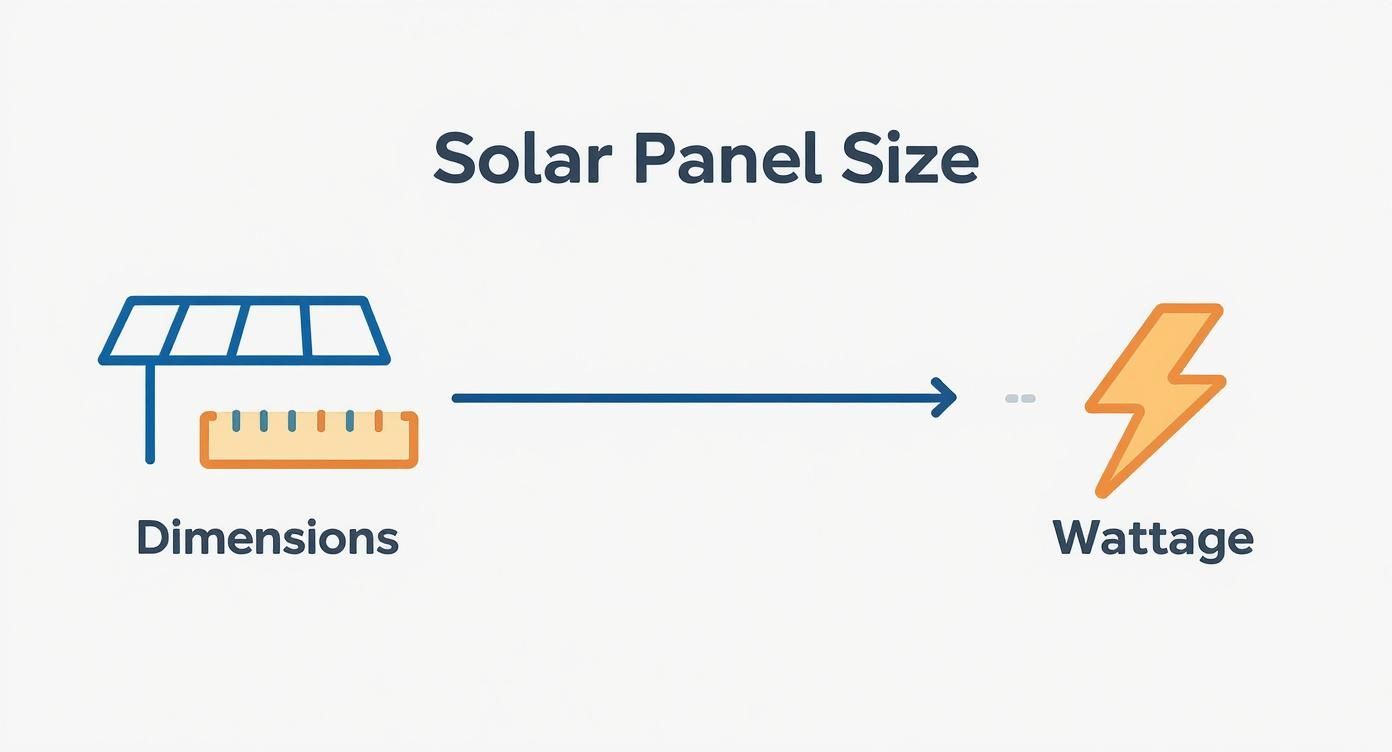
As you can see, the dimensions tell you how much space a panel will take up, but the wattage is what really tells you how much work it can do.
Let’s look at two imaginary panels side-by-side to make this crystal clear. Both are the exact same size—65" x 39"—but one is far more efficient than the other.
Lo más importante: A panel’s efficiency rating is the percentage of sunlight it can convert into electricity. A higher number simply means more power from less space.
Comparing Standard vs High-Efficiency Panels
The table below really drives the point home. You can see how a better efficiency rating directly translates to more energy, even when the physical size of the panel doesn't change. Getting more power per panel often means you can install fewer of them to hit your energy goals.
| Panel Attribute | Panel estándar | High-Efficiency Panel |
|---|---|---|
| Physical Size | 65" x 39" | 65" x 39" |
| Efficiency Rating | 18% | 22% |
| Power Output (Wattage) | ~350 Watts | ~430 Watts |
| Energy Production Boost | Baseline | ~23% More Power |
That difference is huge. The high-efficiency panel generates nearly a quarter more power while taking up the exact same amount of roof space. This is why just looking at the dimensions on a spec sheet can be so misleading.
Of course, keeping those panels performing at their peak is just as important as the initial choice. Regular upkeep is key, so it's worth learning the essential methods for solar PV panel cleaning to boost efficiency.
Sizing Up Your Solar Needs: How to Calculate the Right System for Your Home
Figuring out the right size for your home's solar panel system isn't just a shot in the dark. It's a straightforward calculation based on how you live, where you live, and the roof over your head. Before you even start looking at panel models, the first step is to set a clear goal for how much power your system needs to generate.
It really boils down to three things: your energy habits, the space you have available, and how much sunshine your home actually gets. By working through these, you can get a solid estimate of the system size you'll need, which is measured in kilowatts (kW).
Step 1: Start With Your Power Bills
The best crystal ball for your future energy needs is your past energy usage. Your monthly utility bills are a goldmine of information. Pull them out and look for your total kilowatt-hour (kWh) consumption over the last 12 months.
This number tells you exactly how much electricity your household uses to power everything from the fridge to your kids' gaming consoles. Using a full year of data is key because it smooths out the seasonal spikes—think cranking the AC in August or running holiday lights in December.
If you're looking for a more in-depth guide, check out our post on how to calculate energy consumption.
Step 2: Take a Good Look at Your Roof
Next up, you need to see how much usable real estate you're working with. Not every square foot of your roof is a candidate for solar. You'll want to measure the sections that get consistent, direct sunlight and—if you're in the Northern Hemisphere—ideally face south.
Don't forget to account for the things that get in the way:
- Vents and Pipes: Plumbing vents and other roof penetrations take up space.
- Chimneys: These not only occupy a footprint but can also cast long shadows.
- Skylights: Obviously, you can't cover these up.
- Setbacks: Fire codes often require a clear buffer zone around the edge of your solar array.
Once you subtract these obstacles, you'll have a much more realistic idea of your usable square footage and can start to picture how many panels will fit.
An important part of going solar is making sure your home's electrical system is ready for the job. To ensure your home can safely handle the new power flowing from your roof, you might need professional electrical panel upgrade services.
Step 3: Factor In Your Local Sunshine
Finally, where you live makes a huge difference. We measure solar potential in "peak sun hours," which isn't just how long the sun is up. It’s the average number of hours per day when the sunlight is intense enough for your panels to produce at their maximum rated power.
A home in sunny Arizona might soak up 6-7 peak sun hours a day, while a house in the Northeast could see closer to 4-5. This number directly influences your system size. More sun means you can generate the same amount of electricity with a smaller system.
This chart illustrates how much roof area you might need for different solar system sizes, comparing standard and high-efficiency panels.
Estimated Roof Space Needed Per System Size
| System Size (kW) | Standard Efficiency Panel (Approx. Sq. Ft.) | High-Efficiency Panel (Approx. Sq. Ft.) |
|---|---|---|
| 5 kW | 300 – 350 sq. ft. | 250 – 300 sq. ft. |
| 8 kW | 480 – 560 sq. ft. | 400 – 480 sq. ft. |
| 12 kW | 720 – 840 sq. ft. | 600 – 720 sq. ft. |
As you can see, choosing more efficient panels can help you get more power out of a smaller footprint, which is a great option for homes with limited roof space.
What Really Influences Your Panel Choice?
Figuring out your ideal system size on paper is a great first step, but it’s just that—a first step. When the time comes to actually install panels on your roof, several real-world factors come into play that will shape your final decision. Think of it as moving from a blueprint to the actual construction site.
These variables are what truly guide you from a general idea to the perfect, practical solar solution for your home. They help you sift through all the options to find panels that are effective, smart, and built for the long haul.
Your Roof’s Condition And Layout
Your roof is the literal foundation for your solar power system, so its unique characteristics are a huge deal. Before you even think about panel brands, take a hard look at the roof itself—specifically its age and what it's made of. Putting shiny new panels on a roof that’s due for replacement in five years is a recipe for a very expensive headache. You'll end up paying to take the whole system down and put it back up again.
Once you've cleared that hurdle, the physical layout becomes the next critical piece of the puzzle.
- Orientation: For those of us in the Northern Hemisphere, a south-facing roof is the undisputed champion. It gets the most direct sun all day long.
- Angle (Pitch): The slope of your roof determines how sunlight hits your panels. If it's super steep or nearly flat, you might need special mounting gear to tilt the panels to that sweet spot for maximum energy production.
- Shading: Look around. Do you see tall trees, a neighbor’s two-story house, or even your own chimney? Anything that can cast a shadow on your roof will cut into your energy output, so you have to account for it.
Balancing Your Budget With Panel Efficiency
This is where the classic trade-off between upfront cost and long-term performance comes in. You’ll find that premium, high-efficiency panels cost more, but they also squeeze more power out of a smaller area. This makes them a fantastic choice if you’re working with limited roof space.
Think about it like this: If you can meet your energy goals with 20 high-efficiency panels instead of 25 standard ones, the higher price per panel might be balanced out by needing less racking and a quicker installation, potentially making the total project cost very similar.
The only way to know for sure is to compare quotes for different types of panels. When you see the total installed cost next to the projected energy savings for each option, the best path forward usually becomes crystal clear. For a more detailed breakdown, our guide on cómo elegir paneles solares dives deeper into these comparisons.
Planning For Your Future Energy Needs
Here’s a tip from experience: don't just plan for your life today. Think about where you'll be in five or even ten years. Your energy consumption is almost certain to go up, not down.
Are you thinking about getting an electric vehicle (EV)? Maybe you’re planning to switch to an electric heat pump or finally install that hot tub you've always wanted. These are huge energy draws.
Sizing your system with those future upgrades in mind is one of the smartest things you can do. It is always, always cheaper to install a few extra panels from the get-go than it is to try and add more to your system down the road. Building that buffer in from day one ensures your solar investment keeps up as your life changes.
Comparing Panel Technologies and Their Typical Sizes
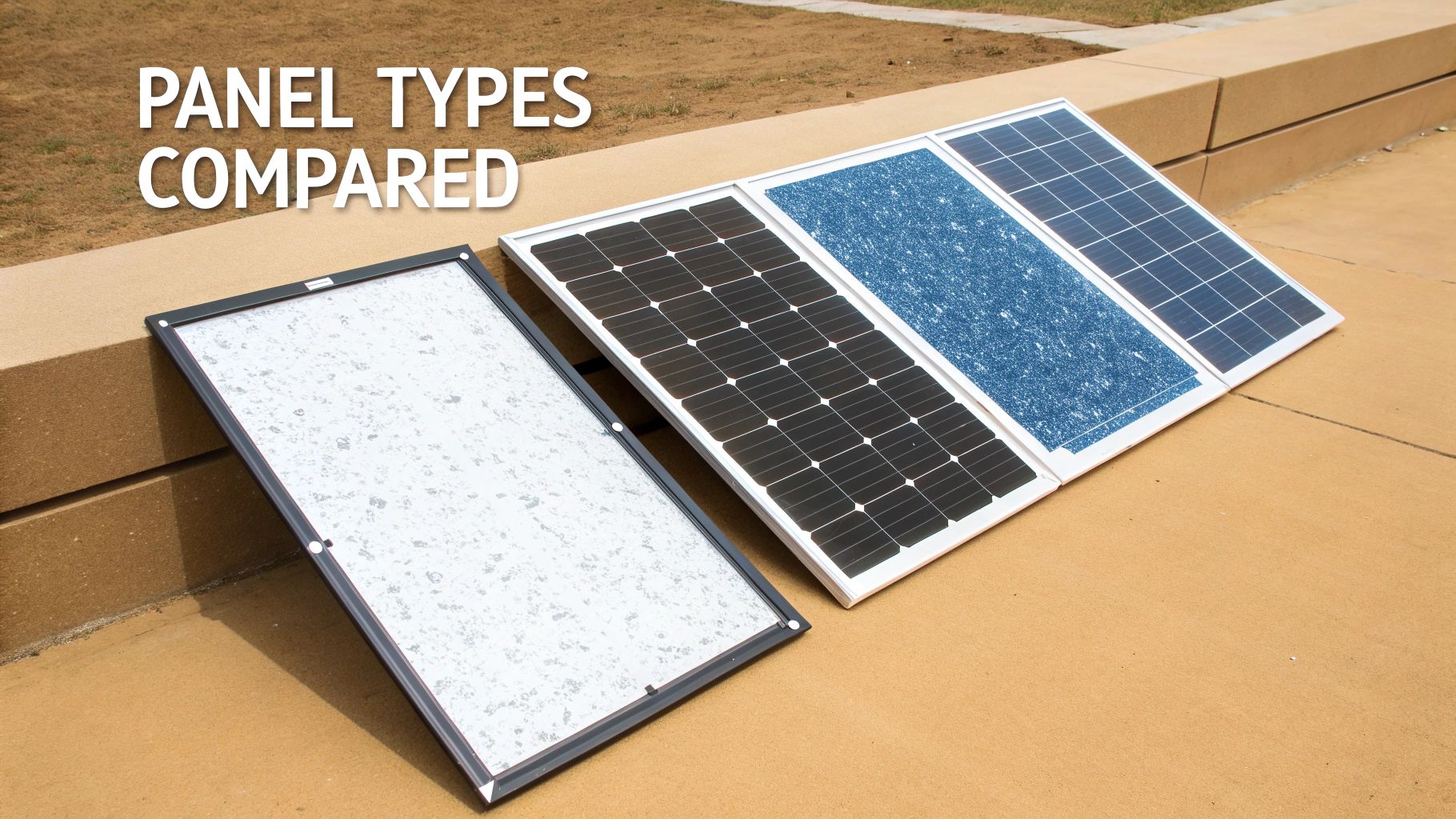
When you start digging into solar quotes, you'll quickly see that not all panels are created equal. The technology packed inside a panel is just as critical as its physical dimensions because it directly affects how much power you get, what it looks like on your roof, and how much you'll pay. Getting a handle on the main options is the first step toward making a smart investment.
For most homes, you'll run into three main types of panel tech: Monocristalino, Policristalinoy PERC. Each has its own manufacturing process, which in turn gives it a unique set of pros and cons.
This chart provides a quick comparison of the most common panel technologies.
Comparación de tecnologías de paneles solares
| Característica | Monocristalino | Policristalino |
|---|---|---|
| Gama de eficiencia | 16% – 24% | 13% – 16% |
| Apariencia | Negro elegante y uniforme | Marbled blue, square cells |
| Coste | Más alto | Baja |
| Lo mejor para | Limited space, modern aesthetics | Budget-conscious, ample roof space |
Monocrystalline Panels: The High-Efficiency Choice
Think of monocrystalline panels as the premium option. They’re known for their impressive efficiency and sleek, uniform black look that many homeowners love. The magic is in how they’re made—each solar cell is crafted from a single, pure silicon crystal. This flawless structure gives electrons a clear, fast lane to travel, which is why these panels are so good at converting sunlight into electricity.
- Eficiencia: This is where they really shine, with ratings typically between 16% and 24%.
- Appearance: You can spot them by their solid black color and rounded cell corners.
- Best For: Perfect for homes with limited roof space or for anyone who wants a clean, modern aesthetic.
The bottom line is that their high efficiency lets you squeeze more power out of a smaller area. If your roof isn't massive, these are often the way to go.
Polycrystalline Panels: The Budget-Friendly Alternative
Polycrystalline panels are the workhorse of the industry. To make them, manufacturers melt multiple silicon fragments together, which is a much cheaper process. This method is what gives them their trademark blue, marbled appearance and perfectly square cells.
Of course, that lower price tag comes with a trade-off. Their efficiency is a bit lower, usually falling in the 13% to 16% range. This simply means you’ll need a larger patch of your roof to generate the same amount of electricity as you would with monocrystalline panels.
A key takeaway is that the type of panel technology you choose creates a direct trade-off between cost, efficiency, and the total roof area required for your system.
PERC Panels: The Modern Upgrade
PERC, which stands for Passivated Emitter and Rear Cell, isn't really a separate type of panel. It's more of an ingenious upgrade that can be added to monocrystalline or polycrystalline cells to make them better.
PERC panels have a special reflective layer on the back of the cells. Think of it like a mirror. Any sunlight that passes through the cell without being absorbed gets bounced right back into it for a second shot at being converted into energy. It's a simple idea with a big impact.
This little innovation can boost a panel's efficiency by more than 1% and also helps it perform better on cloudy days or early in the morning. As the technology has matured, PERC is becoming the new standard. The growing global demand for these high-performance panels has a big influence on production, which you can explore further by reading about where solar panels are manufactured and the scale of production.
Common Questions About Solar Panel Size
As you start to narrow down your options, a few common questions almost always pop up. Let's tackle some of the final details people often wonder about when it comes to solar panel size.
Does A Bigger Solar Panel Always Mean More Power?
Not necessarily, and this is a really important distinction. While it seems logical that a bigger panel would capture more sun, what really matters is its efficiency.
Think of it like this: a small, high-performance engine can easily outperform a larger, clunkier one. The same is true for solar. A compact, high-efficiency panel can generate more electricity than a physically bigger but less efficient model. Always look at the wattage rating first, not just the physical dimensions.
How Many Solar Panels Do I Need For My House?
This is probably the most common question, and the answer has less to do with your home's square footage and more to do with your lifestyle. The number of panels you need depends entirely on how much electricity you use.
A small, all-electric home could easily require more panels than a huge house that relies on natural gas for heating and cooking. The best starting point is to look at your past utility bills to figure out your average energy consumption.
The goal is to design a system that matches your actual energy needs. Your annual electricity usage, measured in kilowatt-hours (kWh), is the number that truly matters.
Can I Mix Different Solar Panel Sizes On My Roof?
This is a tricky one. If your system is built with a traditional string inverter, mixing panels of different sizes or wattages is a bad idea. The entire system's performance will be dragged down to the level of the least productive panel.
However, if your installer uses microinverters o optimizadores de potencia, you have a lot more flexibility. With this technology, each panel operates on its own, so mixing and matching is often possible. It's crucial to have this conversation with your solar installer to make sure everything is compatible and will perform as expected.
Ready to find the perfect solar panel size for your home? The experts at Energía radiante can design a system perfectly matched to your energy needs and roof space. Get your free solar consultation today!

